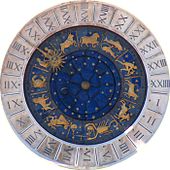| Astrology |
|---|
 |
| Background |
| Traditions |
| Branches |
| Astrological signs |
| Symbols |
A classical planet is an astronomical object that is visible to the naked eye and moves across the sky and its backdrop of fixed stars (the common stars which seem still in contrast to the planets). Visible to humans on Earth there are seven classical planets (the seven luminaries). They are from brightest to dimmest: the Sun, the Moon, Venus, Jupiter, Mars, Mercury and Saturn.
Greek astronomers such as Geminus[1] and Ptolemy[2] recorded these classical planets during classical antiquity, introducing the term planet, which means 'wanderer' in Greek (πλάνης planēs and πλανήτης planētēs), expressing the fact that these objects move across the celestial sphere relative to the fixed stars.[3][4] Therefore, the Greeks were the first to develop the astrological connections to the planets' visual detail.[5]
Through the use of telescopes other celestial objects like the classical planets were found, starting with the Galilean moons in 1610. Today the term planet is used considerably differently, with a planet being defined as a natural satellite directly orbiting the Sun (or other stars) and having cleared its own orbit. Therefore, only five of the seven classical planets remain recognized as planets, alongside Earth, Uranus, and Neptune.
- ^ Goldstein, Bernard R. (2007), "What's New in Ptolemy's Almagest", Nuncius, 22 (2): 271, doi:10.1163/221058707X00549
- ^ Pedersen, Olaf (2011), A Survey of the Almagest, Sources and Studies in the History of Mathematics and Physical Sciences, New York / Dordrecht / Heidelberg / London: Springer Science + Business Media, ISBN 978-0-387-84825-9
- ^ Classification of the Planets
- ^ πλάνης, πλανήτης. Liddell, Henry George; Scott, Robert; A Greek–English Lexicon at the Perseus Project.
- ^ Campion, Nicholas (2022-03-23), "The Planets in Alchemy and Astrology (Medieval and Renaissance)", Oxford Research Encyclopedia of Planetary Science, doi:10.1093/acrefore/9780190647926.001.0001/acrefore-9780190647926-e-178?d=/10.1093/acrefore/9780190647926.001.0001/acrefore-9780190647926-e-178&p=emaila66qfssqpmqfw#acrefore-9780190647926-e-178-bibliography-2 (inactive 2024-11-02), ISBN 978-0-19-064792-6, retrieved 2024-02-11
{{citation}}: CS1 maint: DOI inactive as of November 2024 (link)